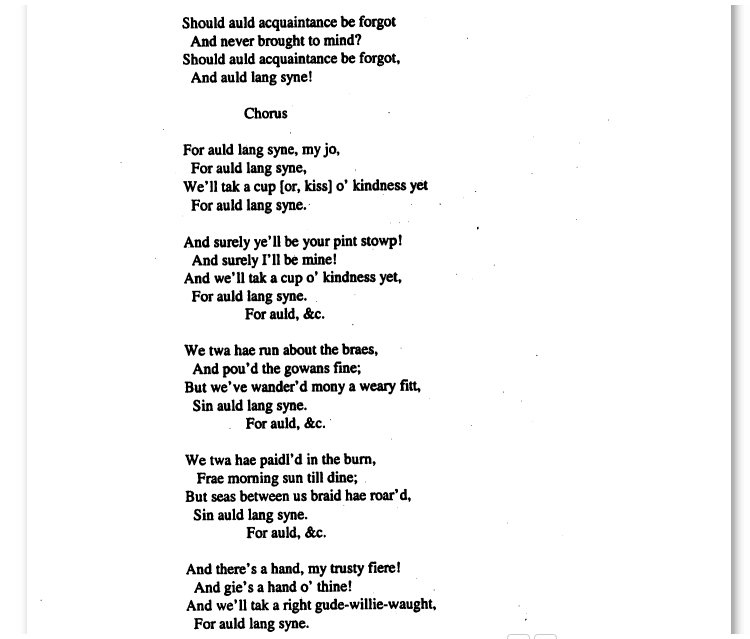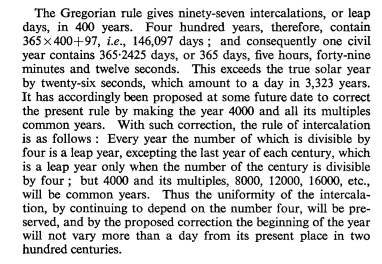New Year’s Day is when we collectively bid adieu to the chapters of the past and embrace the unwritten promises of tomorrow. But before we pop the champagne, let’s travel back in time to learn the deep-rooted history of this special day. And what better compass to guide us through the corridors of history than the Law Journal Library? In our latest edition of Behind the Bindings, we’ll explore just how this celebration came to be.
1. Auld Lang Lie
While Robert Burns is credited as the author of the widely beloved Auld Lang Syne, the original poem is a compilation of older Scottish songs[1]Fergus Ewing & Jennifer Erickson, The Case for Scottish Independence, 25 FLETCHER F. WORLD AFF. 89 (2001). This article can be found in HeinOnline’s Law Journal Library predating Burns. It might be more fitting to dub Burns as the song’s compiler rather than its sole creator. What’s more, this song isn’t reserved solely for New Year; it is used worldwide for various occasions, including weddings, funerals, and sporting events.

2. Dropping Knowledge (and Balls)
Did you ever wonder why we drop a large ball on New Year? Before becoming a New Year’s Eve tradition, in pre-GPS days, the ball atop England’s Royal Observatory in Greenwich was dropped daily at 1 p.m. starting in 1833. This practice aided ship captains in coordinating their navigation equipment,[2]58 LAW LIBR. LIGHTS 1 (2015). This article can be found in HeinOnline’s Law Journal Library and similar balls were installed in coastal areas worldwide.
3. The Pope’s Plan(ner)
The origin of January 1st can be traced back to Pope Gregory XIII, who, in 1582, put forth the last revision to the Gregorian calendar,[3]Latin American Committee on the World Calendar, 69 BULL. PAN AM. UNION 485 (1935). This article can be found in HeinOnline’s Law Journal Library replacing the Julian calendar. The major change was spacing leap years to achieve an average calendar year of 365.2425 days, a closer approximation to the solar year determined by the Earth’s orbit around the sun.

4. Mythical Beginnings
Speaking of January, did you know its name dates back to Roman mythology? January was named after Janus, the god of beginnings, endings, gateways, and doorways.[4]Steve Crawford, Janus-Headed Intaglio, 68 N. IR. LEGAL Q. 305 (2017). This article can be found in HeinOnline’s Law Journal Library This ancient god was depicted as having two faces, one looking forward to the future and one looking back to the past. Similar to Janus, at New Year’s we often reflect on our past year while making plans for the upcoming year.

5. Debts, Deities, and Diets
Resolutions have been a tradition dating back 4,000 years beginning with ancient Babylonians.[5]Benjamin K. Sanchez, Keeping Resolutions Going, 31 GPSOLO 74 (2014). This article can be found in HeinOnline’s Law Journal Library They were the first to celebrate the “new year” even though for them it began in March, not January. During this 12-day celebration, they made promises to the gods to pay their debts. What’s more, the Romans offered sacrifices to Janus, promising good conduct for the coming year. And today, well, most people are resolving to lose weight.
A Resolution to Read (More).
Whether or not one of your resolutions is to read the HeinOnline Blog more (hint hint, wink wink), here’s to a year of conquering challenges, expanding knowledge, and achieving professional or scholarly milestones. Happy New Year and happy researching, from your friends at HeinOnline!
HeinOnline Sources[+]
| ↑1 | Fergus Ewing & Jennifer Erickson, The Case for Scottish Independence, 25 FLETCHER F. WORLD AFF. 89 (2001). This article can be found in HeinOnline’s Law Journal Library |
|---|---|
| ↑2 | 58 LAW LIBR. LIGHTS 1 (2015). This article can be found in HeinOnline’s Law Journal Library |
| ↑3 | Latin American Committee on the World Calendar, 69 BULL. PAN AM. UNION 485 (1935). This article can be found in HeinOnline’s Law Journal Library |
| ↑4 | Steve Crawford, Janus-Headed Intaglio, 68 N. IR. LEGAL Q. 305 (2017). This article can be found in HeinOnline’s Law Journal Library |
| ↑5 | Benjamin K. Sanchez, Keeping Resolutions Going, 31 GPSOLO 74 (2014). This article can be found in HeinOnline’s Law Journal Library |



